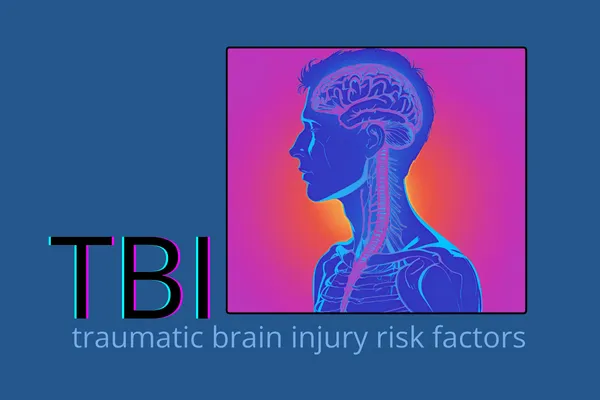
Is Your Lifestyle Increasing Your Risk for TBI?
Introduction
As modern life grows increasingly sedentary, we’re witnessing a rise in Traumatic Brain Injury (TBI) across a wider demographic. While sports and high-impact activities have always been associated with TBI, a closer look at lifestyle factors reveals that reduced physical activity, poor posture, and increased screen time may indirectly heighten our risk of brain injuries, both in frequency and severity. In this post, we’ll dive into the causes of TBI, examine lifestyle risks, and discuss how improving neck conditioning and physical resilience can be key to prevention and recovery.
Countless Blackout Concussions
I experienced a dozen or two blackout concussions during high school football back in the late 80s. The significant time lapses with severe memory loss would last for 20-30 minutes while continuing to perform on the field. I would eventually regain consciousness in the middle of a play.
Fortunately, I didn’t experience physical pain. My symptoms were cognitive, marked by difficulty regulating brain activity. I was pretty good at not even realizing my brain fog became progressively worse over the decades. Finally, in 2018, I discovered how to activate my Ligamentum Nuchae (LN) and reopened the clarity of my brain.
Although I can’t prove it one way or the other, I doubt I would have been so concussion-prone if my LN was doing its job back in the day.
Understanding Traumatic Brain Injury and Its Growing Prevalence
What Is TBI?
A Traumatic Brain Injury is typically the result of a blow to the head, sudden jolt, or impact that disrupts normal brain function. The CDC reports that falls, motor vehicle accidents and sports injuries are the leading causes, with symptoms ranging from mild (headaches, dizziness) to severe (memory loss, cognitive impairment). Yet, lifestyle factors are emerging as silent contributors to TBI susceptibility and recovery challenges.
The Surprising Role of Lifestyle
Historically, active lifestyles and physical labor helped build resilience in muscles and connective tissues, particularly in the neck and upper body, which support and stabilize the head. Today, as more people work desk-bound jobs, long hours in front of screens can cause problems. This new norm has led to weakened neck muscles, poorer posture, and a loss of proprioception—all of which reduce the body’s ability to respond effectively to sudden trauma.
Key Factors Increasing TBI Risk in Sedentary Lifestyles
Muscular Weakness and Instability:
Muscular strength, especially in the neck and upper body, plays a major role in stabilizing the head. Research shows that a lack of physical activity can reduce muscle tone, leading to instability in these areas, which may intensify the effects of a head trauma and increase the risk of TBI.Balance and Proprioception Deficits:
Physical inactivity negatively impacts proprioception, or the body’s ability to sense movement and positioning. Reduced proprioceptive feedback makes it harder to react quickly to prevent falls, a primary cause of TBI among older adults and children.Posture and Neck Health:
Spending hours seated weakens the neck’s structural support over time. Forward head posture throws off the integrity of the neck muscles and increases the risk potential of TBI.Visual and Vestibular Dysfunction:
Screen use can strain the eyes, lead to vestibular dysfunction, and negatively impact balance and coordination. Vision and vestibular impairments can increase the likelihood of falls, further elevating the risk of TBI.Neuroinflammation and Cognitive Decline:
Physical activity has well-documented benefits for reducing inflammation, including neuroinflammation that can exacerbate brain injury symptoms. Regular exercise increases blood flow and neurogenesis, improving cognitive function—important for TBI prevention and recovery.
The Neck’s Protective Role in TBI Prevention and Recovery
The neck’s stability, particularly from the ligamentum nuchae, is crucial to TBI prevention. The LN is a massive ligament that supports the head, helping reduce excessive motion during a collision. Conditioning the LN provides the neck with greater support and alignment, meaning it can better absorb sudden trauma that might otherwise lead to concussions or more severe TBIs.
On the flip side, it is critical to activate and integrate the LN for anyone who seeks to recover from a TBI. Doing so will help relieve pressure, reduce neuroinflammation, and facilitate the brain’s ability to process sensory input effectively.
Additional Steps for Preventing and Recovering from TBI
In addition to neck conditioning, here are a few evidence-based practices that support TBI prevention and recovery:
Regular Physical Activity: Aim for aerobic, resistance, and balance exercises to improve muscular strength, coordination, and proprioception.
Posture Improvement Exercises: Use ergonomic adjustments and exercises to counter forward head posture and build postural confidence throughout the body.
Sensory Integration Training: Exercises targeting the visual and vestibular systems can help reduce disorientation, improve focus, and aid coordination.
Nutritional Support: Anti-inflammatory foods can reduce neuroinflammation, which is beneficial for recovery post-TBI.
Mindfulness and Cognitive Training: Enhancing focus and awareness supports cognitive recovery and helps in reducing symptoms associated with “brain fog.”

Teaching Claire how to discover the length-tension of her nuchal ligament.
Call to Action
Whether you seek to proactively reduce your risk of head injury or improve your rate of recovery from TBI, it’s time to take action.
Freeborn Neck Protocol will activate, integrate, and strengthen your ligamentum nuchae with your intrinsic kinetic chain and fascia network. Our somatic exercise patterns and holistic lifestyle principles will give you the tools needed to self-heal in the comfort of your home.
Our neck conditioning, proprioceptive training, and personalized strategies are tailored to support TBI resilience and recovery. From our online course (FNP 2.0) to one-on-one private coaching via Zoom, we can help you strengthen your body and mind.
